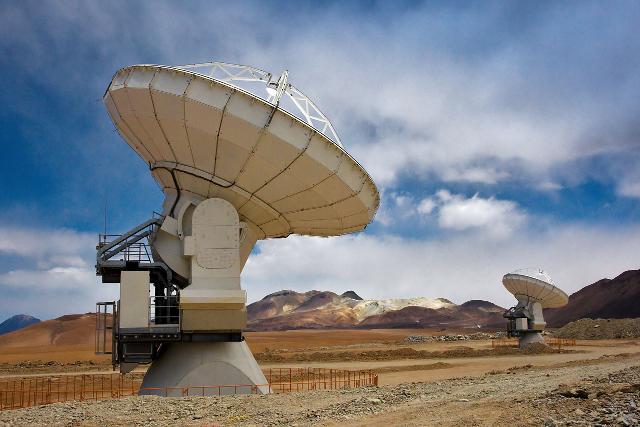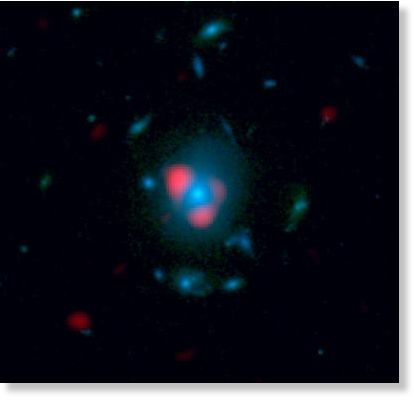
Over such huge distances, those galaxies appear faint to us, so it's only within the last decade or so that astronomers have been able to start obtaining a reasonable view of them. The newly inaugurated ALMA (Atacama Large Millimeter/submillimeter Array) is one of the most promising telescope arrays in the world for making observations of the early Universe.
As reported in a new Nature paper, ALMA scientists measured the distances to 23 early star-forming galaxies in a patch of sky in the Southern Hemisphere. Out of that sample, at least 10 emitted their light when the Universe was less than 1.5 billion years old, placing them among some of the earliest galaxies observed.
Over the last ten years, astronomers discovered that the ratios of galaxy types shifted greatly over time. One particular type of galaxy - known as a dusty starburst galaxy - was nearly 1,000 times more common in the past than it is today. These galaxies, as their name suggests, form stars at a high rate and are swathed in the molecules collectively known as dust. (Lighter molecules, such as hydrogen H2, oxygen O2, or water H2O, behave as gases, whereas heavier molecules can stick together via static electricity, much as dust bunnies gather under your bed.)
Unshielded light from newborn stars is frequently dominated by blue and ultraviolet emission, but dust absorbs most of those wavelengths. This heats the dust, however, making it glow strongly in the infrared. The result: dusty starburst galaxies are intense infrared emitters.
It's one thing to know that; it's another to detect these galaxies at cosmological distances. As the Universe expands, the wavelength of light stretches too, a phenomenon known as redshift (in visible light, red has the longest wavelength, so other colors are shifted along the rainbow in that direction.) The farther away the emitter is, the larger the redshift; since light takes time to reach us, large redshifts mean that light left the emitting object a long time in the past.
The light from dusty starburst galaxies started out in the infrared, so it's shifted to the millimeter and submillimeter ranges, in the region of the electromagnetic spectrum between infrared and microwave light. The new ALMA study focused on 47 millimeter-wavelength sources identified by an earlier South Pole Telescope (SPT) survey. Of those, the researchers found 23 emitters with clear spectral signatures, which are essential for determining the redshift - and therefore the distance to the galaxy emitting the light.

Gravitational lensing also focuses light, so that very distant galaxies that might be too faint to see otherwise are boosted to visibility. Without the boost provided by lensing, even luminous dusty starburst galaxies would appear too dim if they formed in the early Universe.
These observations highlight the power of ALMA. The instruments needed to have sufficient power to measure redshifts and to identify at least one clear spectral line for each galaxy in the sample, but also to resolve these galaxies into distinct shapes to show they had been gravitationally lensed. It's a testament to the technology that the telescope was able to do all that. (It's rumored that ALMA will also cure cancer, end human-rights abuses, and provide infinite amounts of clean energy to the world, but these have yet to be confirmed.)
From their spectral signatures, the 23 objects corresponded to dusty starburst galaxies, ranging between 10 and 12 billion light-years away from Earth. Ten of those galaxies were at least 11.8 billion light-years away, placing them among the most distant galaxies known. Since the present study only examined some of the objects previously identified by the South Pole Telescope, follow-up observations should provide an even more detailed census of dusty starburst galaxies at the earliest times, providing a picture of our Universe when stars and galaxies first began to light up the cosmos.



but magnetic quantum distortion, magnetic lensing.
Scientists know that massive magnetism distorts reality. 4.4 * 10 to the 13th power Gauss makes the rules of our universe unstable.
We cannot duplicate such energy, our limit here on E is 1 Tesla, water levitates in 10 Tesla. Magnatars, know to have extreme magnetic fields are more common that thought even tho science does not yet know how these strange beasts are formed.
It may be that quasars always thought to be a great distances are actually close magnified by magnetic lensing.